Let’s take a journey back to our favorite childhood memories. For many of us, those memories include playing hide-and-seek or kick the can with the neighborhood kids on sultry summer or crisp autumn nights. Inevitably we hid beneath trees and shrubs, holding our breath, frozen in silence lest we be found, until we encountered the dreaded juniper, that monster of a shrub with prickly foliage that left its mark on our flesh for days afterward. We learned to hate that hideous overgrown shrub with its painful foliage, large holes and dead lower branches. I share your pain.
As a garden designer, I am fully aware that when I suggest junipers in the landscape, this all-but-forgotten memory will rear its head and interject itself into our discussion. I mean, who likes junipers? There is, however, a new breed of juniper — a kinder, gentler shrub that has a place in the home landscape. Putting memories aside, let’s take a new and objective look at some great junipers and how to use them in our gardens.
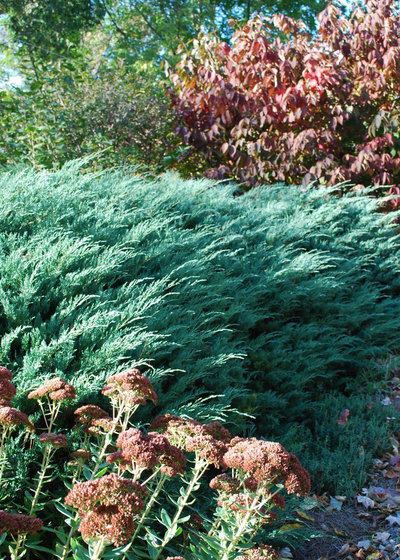
Jay Sifford Garden Design
Junipers provide unmatched texture, color and implied movement in the garden. Notice how this
Grey Owl juniper (
Juniperus virginiana ‘Grey Owl’, zones 2 to 9; find your zone) adds a necessary punch to this garden scheme, showing the Shasta viburnum and Autumn Joy sedum to best advantage.
Angelica Blue (
J. chinensis ‘Angelica Blue’) is a similar variety.
When designing with junipers, I generally work with a color scheme of blue, chartreuse and burgundy. This palette, along with the variety of textures and shapes that junipers provide, is unexpected and exciting. When using this color scheme, take the colors of your home’s exterior into account. For example, you would not want to use this scheme in close proximity to a home with cream or yellow siding, as the chartreuse would be jarring to the eye. In that case I would eliminate the chartreuse and use blues and burgundies for appropriate contrast.
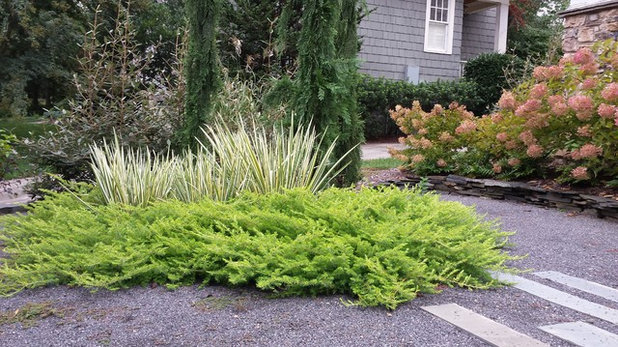
Jay Sifford Garden Design
My favorite juniper is undoubtedly the
Golden Pacific juniper (
J. conferta ‘Golden Pacific’, zones 6 to 9). It grows to a height of 1 foot and spreads 5 feet. Unlike many junipers it tolerates partial shade, adding a much-needed punch of color to a shadier corner of the garden. Additionally, it is probably the juniper with the softest foliage.
I enjoy pairing it with variegated Japanese iris (
Iris ensata ‘Variegata’, zones 5 to 9), as the spreading habit of this juniper perfectly contrasts the upright form of the iris. In shadier areas it pairs well with autumn fern (
Dryopteris erythrosora,
zones 5 to 9)
. The feathery pointed growth of this juniper mimics the shape of the autumn fern’s fronds, adding an unexpected detail.
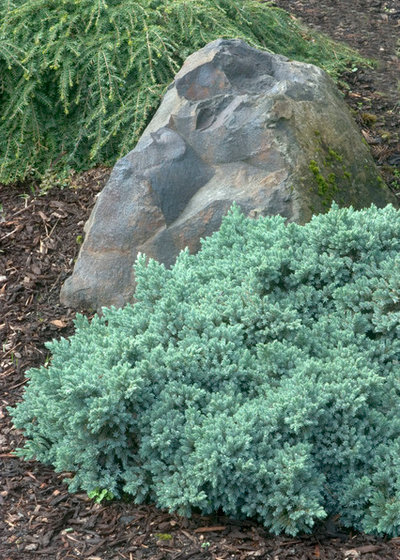
Monrovia
Few shrubs offer as much impact per square foot as
Blue Star juniper (
J. squamata ‘Blue Star’
, zones 4 to 8). Its billowy blue, highly textural foliage reminds me of a cumulus cloud. In the colder months its foliage takes on a red-orange cast, providing winter interest. And like Golden Pacific juniper, this conifer adapts well to partial shade.
Since this slow-growing shrub reaches a mature size of 2 feet high and 3 feet wide, it is a perfect candidate for planting at the front of a mixed border. I frequently plant Blue Star juniper alongside dark-leaved dahlias or with shrubs that sport burgundy foliage, such as Little Devil ninebark (
Physocarpus opulifolius ‘Donna May’, zones 3 to 7), Wine & Roses weigela (
Weigela florida ‘Alexandra’,
zones 4 to 8) or fringe flower (
Loropetalum cvs, zones 7 to 9).
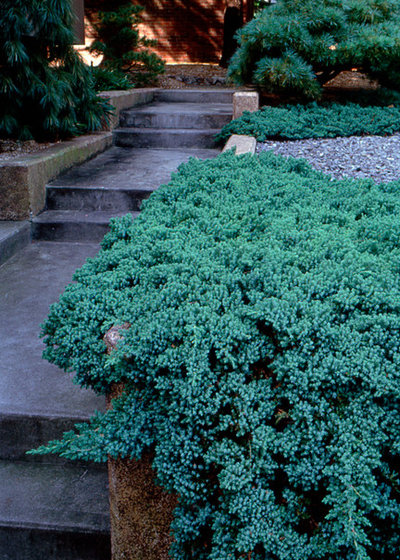
Julie Moir Messervy Design Studio (JMMDS)
Japanese garden juniper (
J. procumbens ‘Nana’
, zones 4 to 9) is an old standby that is gaining new popularity, and rightfully so. Well known by Asian gardeners and bonsai enthusiasts, this juniper attains an average height of 1 foot, which makes it useful at the front of the border, creeping over low boulders or cascading over a stacked stone wall. Its bluish tint adds a rich layer of interest to rock gardens and decorative pots.
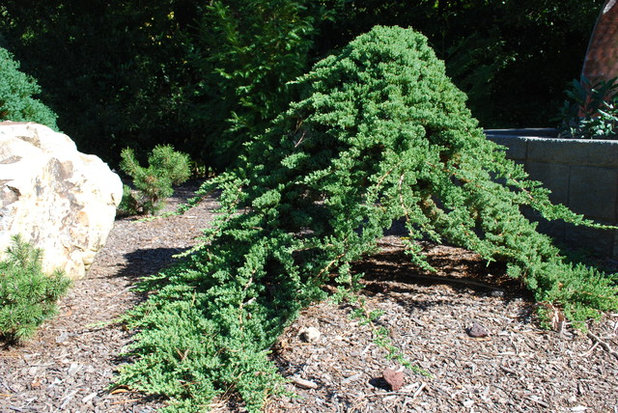
Jay Sifford Garden Design
Occasionally you can find Japanese garden juniper grafted onto a standard (a tall trunk), giving it the graceful, weeping appearance of a small tree. An underplanting of Firewitch cheddar pink (
Dianthus gratianopolitanus ‘Feuerhexe’,
zones 3 to 8) would be beautiful beneath this form of garden juniper.
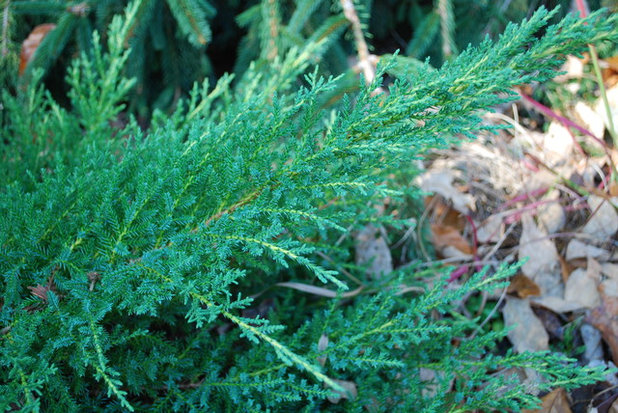
Jay Sifford Garden Design
Daub’s Frosted juniper (
J. chinensis ‘Daub’s Frosted’,
zones 4 to 9) is a small conifer with foliage that combines chartreuse, medium green and blue. Yellow new growth appears in spring, giving the plant a frosted appearance.
Because of its multicolored foliage, Daub’s Frosted is a garden designer’s dream plant. Mine is planted in a bed between a golden spirit smokebush (
Cotinus coggygria ‘Ancot’, zones 5 to 8) and Japanese blood grass (
Imperata cylindrical ‘Rubra’, zones 5 to 9).
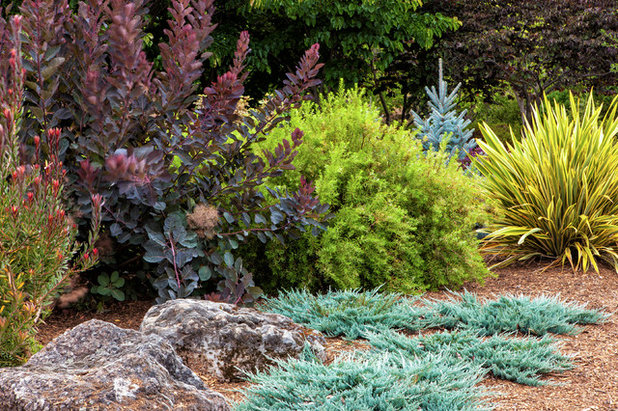
Form and Foliage
Creeping juniper (
J. horizontalis cvs
, zones 3 to 9) is a tough, drought-resistant conifer. It attains a height of less than 8 inches and can spread to 8 feet, making it useful as a ground cover — and a colorful one at that.
Blue Chip creeping juniper, shown here, has a wonderful blue color with incredible texture.
Mother Lode is even shorter and sports bright yellow foliage. Here we see Blue Chip planted in our color palette of blue, chartreuse and burgundy.
Think of creeping juniper as an industrial-grade carpet for your garden. It will help your garden to shine.





